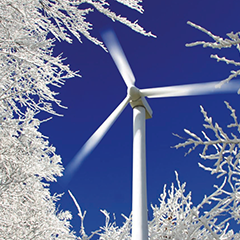Words: Peter Herbert Meier, TÜV SÜD Industrie Service
TÜV SÜD has been operating a 140 m research wind mast in Hessenreuther Wald, a forest region near Erbendorf in Northern Bavaria, Germany, since October 2012. The mast records meteorological data for assessing the site’s viability for wind power and for research purposes and the results are intended to provide information about the actual wind conditions at the site. Now the first interim results after one year of operation provide significant findings: wind speeds exceed expectations and the site’s overall viability for a wind farm is excellent.
Is profitable wind-farm operation possible in Northern Bavaria? This was the question faced by Natural Energy Solutions GmbH &Co KG, Erbendorf, the local energy initiative which plans to build a wind farm in the low mountain range in Bavaria. In the future, the company intends the wind farm to supply clean, renewable power to around 15,000 households in the region. The stakeholders knew right from the start that long-term profitability and cost-effectiveness must be ensured for the multi-million-euro project to be successful.
This quickly gave rise to the question of whether wind conditions, and thus ultimately also the potential energy yield at the projected site, would be sufficient. While modern wind turbines with hub heights of around 140 m harness wind power at greater heights where there is more wind, they also involve higher purchase and construction costs. In addition, the topography of the region, with its low mountain ranges, is extremely complex. Extensive commercial monoculture forests cover the surrounding valleys, hills and mountains, causing the relief to have major influence on the air flows.
More research needed for sites in minor mountain ranges
So far, these complex topographic formations have made it difficult to provide reliable predictions of the potential energy yields. While initial rough estimates of the potential yields, and even computer-based 3D simulation programmes, provided first indications of possible high-yield sites for this project, it must be remembered that, depending on the method used, all calculated data and forecasts involve major or minor errors. Topography may cause greater than normal variations in the actual wind conditions. Depending on the wind direction, air flows may be diverted, slowed down or accelerated differently. As a general principle, wind speed may be higher or lower than expected from the models – both scenarios are theoretically possible.






























